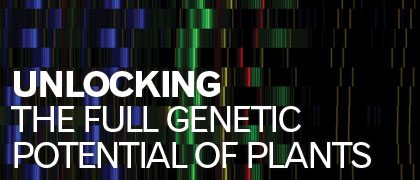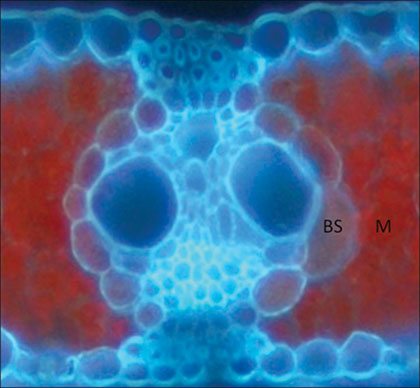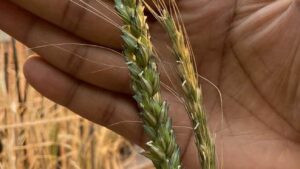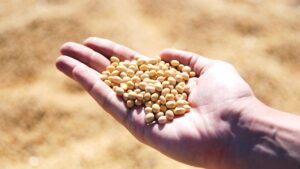Since 1995, the genomes of nearly 50 plants have been sequenced and thanks to advances in technology, the rate at which these sets of genetic instructions are being deciphered is increasing rapidly.
Just 10 plant genomes were sequenced between 2000 and 2008. In 2012, by comparison, 13 genomes were published and another 12 in 2013. They include major grain, fruit and vegetable crops such as corn, wheat, barley, rice, soybeans, hemp, cotton, flax, apple, peach, watermelon, tomato, strawberry, potato, cucumber, grape and Chinese cabbage.
“Having these increasingly comprehensive collections of DNA allows us to mine useful genes more efficiently and make better use of them,” says Owen Hoekenga, research molecular biologist for Cornell University.
Once the genome has been sequenced, genotyping tools can be used to determine the genetic variants that any individual plants may possess. Genotyping provides information about the complete genetic makeup of a particular plant variety or species. It allows breeders to very quickly and easily identify beneficial or desirable traits that can potentially be deployed across varieties of the same species, and in some cases across different plant species using transgenic technologies.
“As genotyping tools are becoming increasingly inexpensive, it’ll be more straightforward to deploy traits into a wider range of germplasm for broader impact,” says Hoekenga. “The question is whether or not the use of trans-gene technologies is going to expand beyond its current base in maize, soybeans, sugar beet and cotton to include other economically important crops like rice or wheat.”
Shotgun Sequencing
In November 2012, a team of international scientists announced that they had sequenced the wheat genome that contains 96,000 genes and is five times larger than the human genome. That was followed by sequencing of the barley genome in October 2012, which has 5.3 billion letters of genetic code.
Because the genomes of plants such as barley and wheat are so large, scientists use a technique called shotgun sequencing, which essentially breaks the genome into smaller, more manageable segments for analysis and then reassembles them.
“Shotgun sequencing is being routinely applied to increasingly large and complex organisms,” says Hoekenga. “It’s so much more efficient in terms of how much information you recover from a single experiment.”
DNA Mapping and Sequencing
Many people mistake DNA mapping and sequencing for the same thing, but they are different processes that provide different information. A DNA (or genetic) map shows where certain things (identified with genetic markers) are located and in what order on the chromosome of a genome. DNA sequencing (of a genome) is much more comprehensive and reveals not just where things are on the chromosome, but also what they look like and what they do.
Genetic sequencing identifies the specific genes or forms of a gene (alleles) that confer or control traits or functions that could be useful to plant breeders, such as those that influence yield, oil or protein content, drought tolerance, disease or pest resistance.
“It’s now more time and cost efficient to use genome sequencing to ask genetic mapping questions because for the same amount of time, effort and cost we can get 100,000 pieces of information simultaneously, rather than 10,” says Hoekenga. “In terms of creating a more comprehensive snapshot of the genome, it’s the difference between a masterpiece and a little paint-by-numbers picture. You have so much more information of such greater depth that it’s just more useful.”
A gene, dubbed the “scarecrow gene,” has been studied in the stems and roots of plants. Cornell University researchers, however, discovered that the gene is also found in the leaves of certain plants. The C3 pathway is the most common photosynthetic pathway in plants and is found in crops such as rice. The C4 photosynthetic pathway is used in corn, sorghum and millet, which are grown in arid climates. Plants that use the C4 pathway use water, nitrogen and sunlight 50 percent more efficiently in areas where water is scarce than those that use the C3 pathway.
Gene Silencing Technology
Understanding how plants turn specific genes on and off to perform certain functions or defend themselves may pave the way for new varieties with increased pest and disease resistance through the use of gene silencing technology.
One of these technologies, RNA interference (RNAi) is being employed by some major seed companies, such as Monsanto, to try and provide resistance to pests such as corn rootworm.
“RNAi is a one of a number of mechanisms by which genes can be silenced or turned off,” says Hoekenga. “Part of RNAi relies on the fact that in plants there are sensing mechanisms that can recognize RNA molecules that they regard as being pathogens in some way. If you can introduce into a plant a sequence that creates an RNA molecule that matches the gene you want to turn off, the plant will recognize this trigger and turn off the target gene. Gene silencing can not only be used to silence genes that exist in the plant, but they can also be used to silence genes of organisms that interact with the plant [like diseases and pests].”
Improving Yields
Two genetic discoveries in 2013 may help raise global crop yields. In November, an Israeli agri-tech company announced it hopes to increase crop yields without the aid of genetic modification by speeding up the multiplication of crop genomes using a technique called genome doubling.
Genome doubling occurs in nature, but takes thousands of years. Scientists have long tried to speed up the process, but could not avoid damage to certain agronomic characteristics of the crop.
Hoekenga explains that although this may be a new way to use genome doubling (also called polyploidy), it’s not a new technology. “It doesn’t surprise me that someone is inducing polyploidy as a means of agronomic improvement, because that kind of technology has been around for a number of years now,” he says, adding that it has been used successfully in the past to add more genetic diversity to bread wheat, for example.
Cornell researchers also announced in 2013 the discovery of a scarecrow gene, which leads to more efficient plant photosynthesis. Researchers say the discovery opens the door to the transference of C4 plant mechanisms into C3 plants, such as wheat and rice, which would allow them to be grown in hotter, dryer environments with less fertilizer and still achieve up to 50 percent higher yields.
Pests and Diseases
The genomes of pests such as the pea aphid and the diamondback moth have already been sequenced and a recent breakthrough has brought researchers one step closer to improved resistance to soybean cyst nematode. For many years growers have been planting soybeans with just one gene, Rhg1, as a defense against SCN. A U.S. research team has discovered that Rhg1 is actually three genes located next to each other on the chromosome, which work together to provide SCN resistance and, if this gene group can be identified in multiple varieties, should provide more options to develop better resistance.
Diseases are also being examined at the molecular level. An international team of scientists in 2010 cracked the genetic code of a plant pathogen, Hyaloperonospora arabidopsidis, that causes downy mildew disease. This “stealth bomber” of plant pathogens is able to sneak undetected past a plant’s immune defenses and understanding the genetic mechanisms it uses to do this will be useful in developing better resistance to a variety of plant pathogens in the future.
Other research in the U.S. is trying to identify genetic targets to give resistance to fungal diseases such as fusarium, root rot and sudden death syndrome in corn, soybeans and wheat. Researchers in Canada have identified and are developing genetic markers for three genes providing resistance to the Ug99 strain of wheat stem rust.
Bioinformatics
Along with genome sequencing technologies comes a whole supporting cast of computational and bioinformatics technologies that are essential for analyzing information gathered in the lab.
“It’s an area that is growing fast and which is going to be increasingly important in the future,” says Hoekenga. “Bioinformatics is the computerized analysis of data,” he explains. “It was truly novel 20 years ago, but it’s an increasingly important skill set as the experimental biology gets easier and easier. Now we can generate more and more data which means there’s increased emphasis on analysis rather than actually collecting the original information.”
Next Generation Genome Sequencing
The next generation of sequencing technologies will further accelerate the plant breeding process by producing even greater amounts of information simultaneously and at much faster speeds.
Pyrosequencing is a next generation technology that measures tiny flashes of light produced by different chemical reactions in DNA strands. “In one single pyrosequencing reaction you are looking at hundreds of millions of sequences simultaneously, so you are generating as much information as is found in the whole human genome at once,” says Hoekenga. “Your ability to generate data is vastly increased.”
The Future of Genomics
As genomic and computer technologies continue to become more efficient, cost effective and complex, what will the genetic secrets they unveil tell us and how will they help us prepare for agriculture a century from now?
“A big question is what is agriculture going to look like in the face of global climate change?” asks Hoekenga. “What will the agro-ecology look like if rainfall patterns become increasingly erratic and temperature fluctuations become increasingly larger? What is that going to do to both perennial crops and annual crops? Personally, I think definitely one of the big challenges is how do you respond to or anticipate increasingly erratic conditions and what can we do in terms of creating varieties with greater stress tolerance or other sorts of things.”
Angela Lovell














